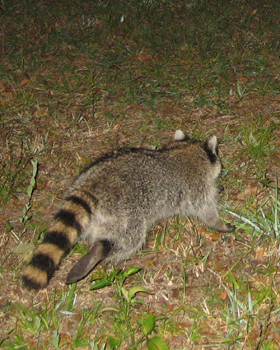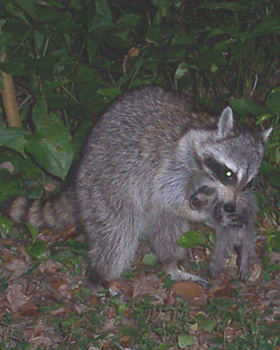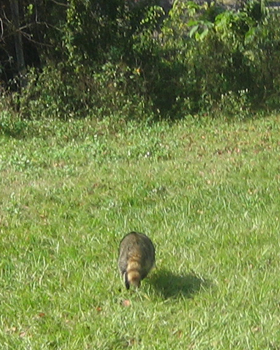Do local or state laws apply? - Yes, though many people are unaware of such laws, and enforcement is often lax. Some states require that you release the animal exactly where you caught it, or euthanize the animal
on the spot. Read more about killing raccoons here. In many states it is not legal to transport and relocate raccoons. This is often because of laws regaring Rabies Vector Species (RVS), or animals that could
be rabid. You can find the rules in your state by checking the locations page in your state. Of course, many people don't know about or follow state law, simply driving the animal to "the woods" to let it go.
How should I transport it? - Wear thick leather gloves while transporting the cage, and hold the trap away from your body, since a raccoon can reach out several inches with its claws. Do not stick a finger anywhere in the
cage, or the animal may lunge and bite you, very quickly! Place the cage in a truck bed, trunk of car, etc with a drop cloth underneath if you want to catch waste. Make sure the trap is stable, and won't roll during transport.
How far away should I bring it? - Raccoons, like many animals, have an uncanny ability to find their way back to their original territory. And with good reason - a
raccoon grew up learning its own territory, and establishing a space
there. It will have great difficulty thriving in a new territory, or established raccoons will outcompete it or drive it out. They will travel far to return to the original territory, so if you don't want to see it again, it's recommended to
bring it a minimum of 5, or even 10 miles away from the capture site.
I should release it in the woods, right? - This is a strange matter. Many people think they're doing the raccoon a real favor by trapping it in a city or suburbs and taking it away to a better "more natural" forest habitat. But a
raccoon living in the city was there for a reason! Raccoons are largely urban animals, and raccoon population densities are higher, often much higher, in urban areas than undeveloped wild areas. An urban raccoon will probably stand a better chance
of survival in a new urban habitat than "the woods". But to relocate a raccoon there is just bringing a potential problem animal to a new neighborhood of people. In short, there's no good answer to this question. A nearby water source is probably
the only requirement that you can purposely fulfill.
Can I drop it off in a local park or state forest? - In some states it is legal to relocate, but not on public lands. Many professional wildlife operators in such states who do offer relocation
have agreements with private property owners. It is always up to you to decide to research or follow local law, and to find a suitable relocation area.
Will the raccoon attack me when I release it? - No, it'll want to flee out of sheer terror and its own instinct to survive, just like you would in the same situation. That said, you should still exercise caution while handling
and opening the trap. In the rare case in which an animal won't leave a trap, you can either prop the cage door open and back away and wait, or blow on the animal to make it run out.
What is the survival rate of relocated raccoons? - We don't know. We haven't gathered good data on the subject. Most studies conducted by other groups indicate mortality rates above 50% within the first two months. That's pretty poor prospects.
Nature is not easy, even in good conditions.
Might I want to release it in the same place I caught it? - This question may seem silly, but if your situation is that a raccoon is entering a house, under a shed, etc, you can also hold it in the cage while you perform repairs to prevent
the animal from going back in the structure, and then release it on site. Beware, of course, of the possibility of a nest of baby raccoons in the structure, in which case the female raccoon will desperately claw her way back
in, and that failing, the young will starve to death.
What if I have a mother raccoon and a litter of young? - If you find yourself in this circumstance, and want to relocate them all together, keep the young in a box, preferably with a hot water bottle or heating pad. Set the box in the new
relocation area, and allow the mother raccoon to see and sniff it. When you release her, she will run away. But not too far. Leave the area and allow her to retrieve her young and attempt to establish a new den. Return in one day, and if any of the young
remain in the box, bring them to a local wildlife rehabilitator.
What's the Right Thing To Do? - We believe in preventative tactics or exclusion tactics, which allow conflict raccoons to continue to live in the same territory, while no longer causing you the specific problem they caused prior.
For effective ways to solve a raccoon problem yourself, or to find local help, click the below buttons:




